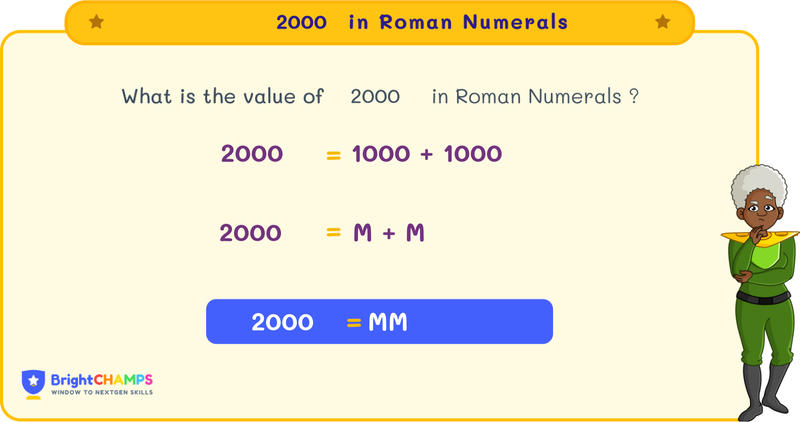
 199 Learners
199 LearnersLast updated on May 26th, 2025

2000 in Roman Numerals

Roman numerals are a way of expressing numbers using symbols. I, V, X, L, C, D, and M are the symbols we use. Roman Numerals are used in royal titles, book names, sequences, and so on. Here we will be discussing Roman Numerals, rules, and examples.
What is 2000 in Roman Numerals?
The royal titles, such as Henry I, Henry II, and so on. Have you noticed the names and wondered what these symbols (I and II) represented?
Those are the Roman Numerals. Earlier people counted using fingers, sticks, bones, etc. When life became complex, a standard form was required to count. Ancient Romans used the Roman Numeral system to count. I (1), V (5), X (10), L (50), C (100), D (500), and M (1000) are the symbols we use to count.
In Roman Numerals, we use MM to represent 2000, here M is 1000 and is repeated twice.
Let’s learn more about Roman Numerals and how we write them.

Struggling with Math?
Get 1:1 Coaching to Boost Grades Fast !

Basic Rules for 2000 in Roman Numerals
There are certain basic rules to write a number in Roman Numerals. In this section, let’s discuss some basic rules that need to be remembered when writing a number in Roman numerals.
Rule 1: Addition Method
The addition method is used when the smaller number is placed after the larger number. For example, VI → V + I → 5 + 1 = 6
Rule 2: Repetition Method
To write a large number, there are certain Roman Numerals that can be repeated up to three times. For example, III → 3.
Rule 3: Subtraction Method
If a small number precedes a large number in Roman Numerals, we subtract the smaller number from the larger number. For example, IX → X - I → 10 - 1 = 9
Rule 4: Limitation Rule
The symbols cannot be repeated more than three times and some symbols like V, L, and D cannot be repeated. For example, we won't write VV for 10; instead, we use X, and 8 is written as VIII, not IIIIIIII.
How to Write 2000 in Roman Numerals
Let’s now learn how to write 2000 in Roman Numerals. Follow these methods to write the number in Roman Numerals.
- By Expansion Method
- By Grouping Method
2000 in Roman Numeral by Expansion Method
In the expansion method, based on the place value, the number is broken down. In this section, we will learn how to write 2000 in Roman numerals using the expansion method.
To write 2000 in Roman Numerals, follow the steps:
Step 1: The number is broken down based on the place value. Place values are ones, tens, hundreds, thousands, etc.
For 2000, we write it as 1000 + 1000
Step 2: Converting the number into Roman Numerals
1000 in Roman Numeral — M
Step 3: Combining the Roman Numerals together.
Therefore, 2000 in Roman Numerals is M (1000) + M (1000) = MM
2000 in Roman Numeral by Grouping Method
When writing a large number in Roman Numerals, we group the number.
To write 2000 in Roman Numerals, we group 2000 as 1000 + 1000
1000 in Roman Numeral — M
So, 2000 is written as MM in Roman Numerals.

Common Mistakes and How to Avoid Them in 2000 Roman Numerals
Students make mistakes when writing numbers in Roman Numerals. To master Roman Numerals, we can learn a few common mistakes and the ways to avoid them.
Level Up with a Math Certification!
2X Faster Learning (Grades 1-12)


2000 in Roman Numerals Examples

Problem 1
A historian discovers MM ancient coins and divides them equally among XL archaeologists. How many coins does each archaeologist receive?

Each archaeologist receives L coins.
Explanation
To find the number of coins each archaeologist receives, divide the total number of coins by the number of archaeologists.
MM = 2000
XL = 40
2000 / 40 = 50
50 in Roman numerals is L.

Problem 2
A marathon has a total distance of MM meters. If a runner has completed DCCC meters, how many meters are left for them to run?

The runner has MCC remaining meters to run.
Explanation
To find the remaining distance, subtract the distance already run from the total distance.
MM = 2000
DCCC = 800
2000 - 800 = 1200
1200 in Roman numerals is MCC.

Problem 3
An artist paints MM portraits in a year. If they complete CCCL portraits in the first quarter, how many portraits do they still need to paint?

The artist needs to paint MDCL more portraits.
Explanation
To find the remaining portraits to paint, subtract the completed number from the total.
MM = 2000
CCCL = 350
2000 - 350 = 1650
1650 in Roman numerals is MDCL.

Problem 4
A city plans to plant MM trees over the next decade. If they plant CLX trees each year, in how many years will they complete their plan?

The city will complete their plan in XII years.
Explanation
To find the number of years needed, divide the total number of trees by the number of trees planted each year.
MM = 2000
CLX = 160
2000 / 160 = 12.5 Since they need complete years, it will take XII years (12 full years plus a partial year).

Problem 5
A writer aims to write MM pages of a novel. If they write C pages each month, how long will it take to complete the novel?

It will take XX months to complete the novel.
Explanation
To find the time required, divide the total number of pages by the number of pages written each month.
MM = 2000
C = 100
2000 / 100 = 20
20 in Roman numerals is XX.

Turn your child into a math star!
#1 Math Hack Schools Won't Teach!


FAQs on 2000 in Roman Numerals
1.What is 1999 in Roman numerals?
2.How to write 2000 in Roman numerals?
3.What is 2023 in Roman Numerals?
4.Is MM a prime number?
5.What are the multiples of 1000?
6.How can children in Oman use numbers in everyday life to understand 2000 in Roman Numerals?
7.What are some fun ways kids in Oman can practice 2000 in Roman Numerals with numbers?
8.What role do numbers and 2000 in Roman Numerals play in helping children in Oman develop problem-solving skills?
9.How can families in Oman create number-rich environments to improve 2000 in Roman Numerals skills?
Struggling with Math?
Get 1:1 Coaching to Boost Grades Fast !

Important Glossaries for 2000 in Roman Numerals
- Addition Rule: Addition method is used when a large number is followed by a smaller numeral, and the values are added. For example, VI = V + I = 5 + 1 = 6.
- Grouping Method: Here, the given numbers are grouped based on their place value and then converted into Roman numerals. For example, 2000 = 1000 + 1000 = MM.
- Repetition Rule: Certain symbols (I, X, C, M) in the Roman numeric system can be repeated only up to three times. For example, MM = 2000 (M is repeated twice to represent 2000).
- Subtraction Method: Used when a smaller numeral precedes a larger one, indicating subtraction. For example, IX = X - I = 10 - 1 = 9.
- Limitation Rule: Some symbols like V, L, and D cannot be repeated. For example, 1000 is M, and 2000 is MM, not DDDD.
Explore More numbers
![Important Math Links Icon]() Previous to 2000 in Roman Numerals
Previous to 2000 in Roman Numerals
About BrightChamps in Oman


Hiralee Lalitkumar Makwana
About the Author
Hiralee Lalitkumar Makwana has almost two years of teaching experience. She is a number ninja as she loves numbers. Her interest in numbers can be seen in the way she cracks math puzzles and hidden patterns.
Fun Fact
: She loves to read number jokes and games.




